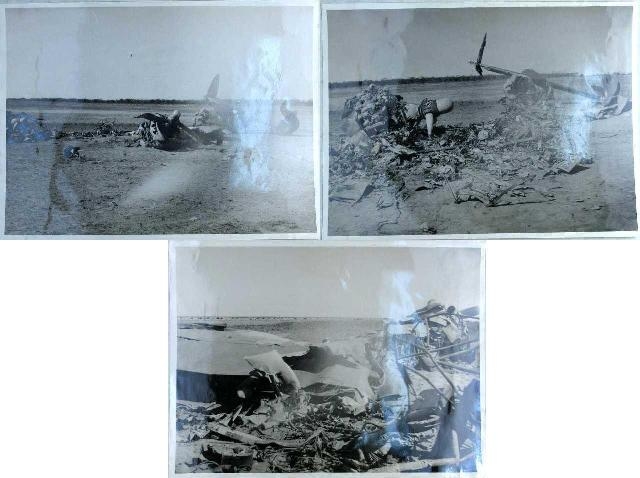Given the sacrifice these brave men paid I think this cache is deserving of being relatively challenging multi
On the 17th of January 1942, RAAF Lockheed Hudson A16-144 of 14 Squadron RAAF crashed and caught fire after stalling from about 400 feet after takeoff at Ceduna in South Australia, killing all 6 personnel on board. The aircraft was one of four Lockheed Hudsons on a ferry flight from Laverton in Victoria to Pearce in Western Australia. It crashed to the north east of Ceduna airfield.

Lockheed Hudsons similar to A16-144
Image copyright: Copyright expired - public domain
Want to know more about the RAAF Lockheed Hudson: RAAF Lockheed Hudson
From the West Coast Sentinel - 23 January 1942
SIX KILLED IN AIR CRASH
SERVICE PLANE BURSTS INTO FLAMES IN TAKING OFF
IMPRESSIVE FUNERAL OF R.A.A.F. MEN
In taking off at a South Australian aerodrome last Saturday a service plane crashed and burst into flames, incinerating the six occupants. Death was believed to have been instantaneous, as the airmen were still in their seats when the flames subsided.
The plane had just refueled and was resuming its journey. It rose from the ground, traveled about half a mile and then suddenly shot up in the air, turned to one side and nosedived to the ground. It landed, bumped on about 50 yards crashed again, and then burst into flames.
The occupants were:-
Squadron Leader Gordon Laming, 29, married, of Melbourne, Victoria.
Flight Lieutenant David Burton Bradley, 24, single, of Sydney, New South Wales.
Sergeant Frederick Archibald Walker, wireless operator air gunner, 23, married, who enlisted at Adelaide and whose next of kin resides in New South Wales.
Sergeant Ronald Dow, airman pilot, 26, married, of Queen’s Park Western Australia.
Sergeant Robert William Westcott, wireless operator air gunner, 26, single of Ballarat, Victoria.
Corporal William Clyde Lindsay, wireless operator, ground, 30, single, of Yuelba, Queensland.
Sergeant Walker enlisted in the Air Force towards the end of 1940, and was posted to Somers initial training school, a wireless air gunners’ school, a bombing and gunnery school and subsequently to an operational squadron. Before enlistment in the air force he was an electrician. He was educated at Unley High School and the Marconi School of Wireless.
Flight Lieutenant Bradley, before enlistment in the air force in July 1937, was a clerk. He had been on active operational duty since the middle of 1938. He was educated at the Sydney Technical High School.
The heat from the blaze was so intense that no one could approach it for nearly a half an hour. When the bodies could be retrieved they were burnt beyond recognition. Identification discs gave the clue to their names.
An enquiry was immediately held by the R.A.A.F. Enquiry Board, but no statement was issued.
The neighbouring township and districts were cast over with gloom at the tragedy, which was the most terrible in their history.
Four of the boys were buried locally. They were William Lindsay, Ronald Dow, David Bradley and Gordon Laming. The remaining two were removed to their home towns at the request of relatives.
A large crowd attended the funeral service, which was conducted impressively by local clergy on Monday afternoon.
The cortege was followed by nine members of the R.A.A.F. and members of the local R.S.S. & A.I.L.A. and Home Guard. Six members of the R.A.A.F. acted as pallbearers.
Although there was little time there were many floral tributes. Among public bodies which laid tokens at the graveside were the R.A.A.F., the Red Cross, the F.F.C.F., the Cheer Up Club, the R.S.S. & A.I.L.A., the local district council, the V.S.D., and the Home Guard, and there were many forthcoming from private sympathisers.

Wreckage of A16-144 at Ceduna
To find this cache proceed to the given coordinates.
WAYPOINT 1
At the given coordinates you will find the headstones of four of the crew.
On one of the headstones is a six digit number beginning with a four (4). This number represents ABCDEF.
On another headstone you will find a five digit number beginning with a two (2). This number represents GHIJK.
Waypoint 2 can be found at S32 0D.AEH E133 4J.EGC
WAYPOINT 2
At this waypoint you will find an information panel. You will need to find the number of letters in each of the following words:
L = Line One, Word Two
M = Line Three, Word Six
N = Line Four, Word One
O = Line Six, Word One
P = Line Eight, Word Five
Q = Line Ten, Word One
R = Line Twelve, Word Two
S = Line Fifteen, Word Four
Waypoint 3 can be found at S32 0L.MNO E133 4P.QRS
WAYPOINT 3
Please note:
- To access this waypoint you will have to climb over a fence. The owner has given his permission for you to do this but must only be on foot.
- You can drive to a point close to the waypoint but please do not drive onto the private property.
- The track leading in can be very corrugated and has limited opportunities to turn around.
- The track is unsuitable for conventional vehicles if wet/muddy.
- Please respect the location and leave all artifacts as you find them.
At this wayppoint you will find a plaque. On the bottom of the plaque is a seven digit number. This represents TUVWXYZ.
The final waypoint can be found at S 32 0W.ZYX E133 4(U-W).(V+Z)(T+Z)(V+W)
captash has kindly agreed to assist in the maintenace of this cache
